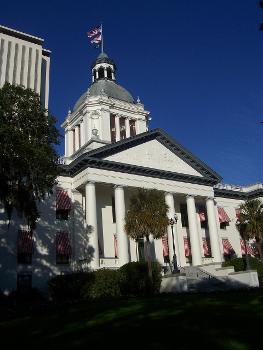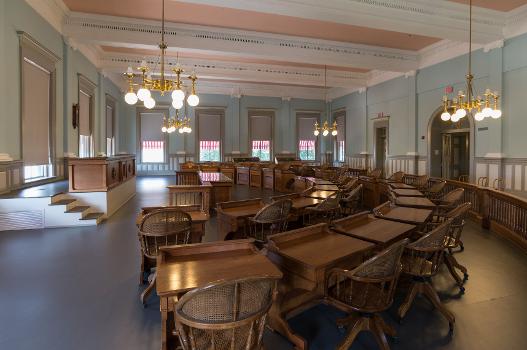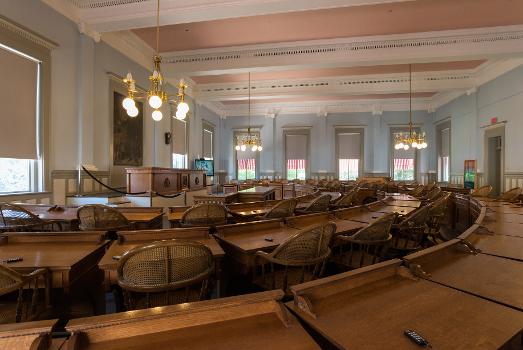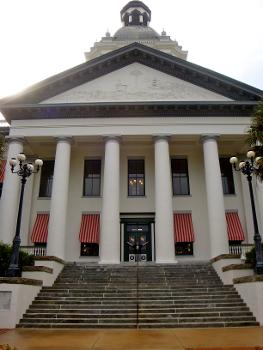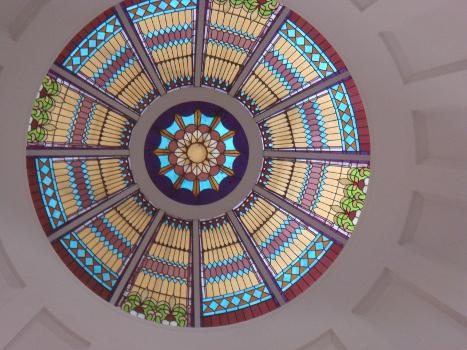General Information
| Completion: | 1845 |
|---|---|
| Status: | in use |
Project Type
| Function / usage: |
original use: Parliament building current use: Museum building |
|---|
Awards and Distinctions
| 1973 |
for registered users |
|---|
Location
| Location: |
Tallahassee, Leon County, Florida, USA |
|---|---|
| Coordinates: | 30° 26' 17.16" N 84° 16' 53.76" W |
Technical Information
There currently is no technical data available.
Excerpt from Wikipedia
The Florida State Capitol in Tallahassee, Florida, is an architecturally and historically significant building listed on the National Register of Historic Places. The Capitol is at the intersection of Apalachee Parkway and South Monroe Street in downtown Tallahassee, Florida.
Sometimes called "The Old Capitol," the Historic Capitol, built in 1845, was threatened with demolition in the late 1970s when the new capitol building was built. Having been restored to its 1902-version in 1982, the Historic Capitol is directly behind the new Capitol building. Its restored space includes the Governor's Suite, Supreme Court, House of Representatives and Senate chambers, rotunda, and halls. Its adapted space contains a museum exhibiting the state's political history, the Florida Historic Capitol Museum, which is managed by the Florida Legislature. On April 18, 2012, the AIA's Florida Chapter placed the Historic Capitol Building (Restoration) on its list of Florida Architecture: 100 Years. 100 Places.
The New Tower houses executive and legislative offices and the chambers of the Florida Legislature (consisting of the Florida Senate and Florida House of Representatives).
The Florida Department of Management Services maintains the Capitol Complex, which is open to the public Monday through Friday, 8 a.m. to 5 p.m. (excluding state holidays).
Names
The buildings are universally, though informally, known as the Old Capitol and the New Capitol; the former is sometimes called the Historic Capitol, or also, confusingly, the Florida State Capitol. The latter was its official name prior to the construction of the New Capitol in 1977, and was so called by the National Park Service even after the New Capitol was operating. Its legal name today, however, is the Florida Historic Capitol Museum. The New Capitol, as a whole, does not have a legal name. When it was planned, the Capitol Complex (which is a legal name) was going to consist of the House and Senate chambers, and the twenty-two-story office building.
History
Tallahassee was named Florida's capital in 1824, midway between the then-largest cities in the state, St. Augustine and Pensacola. The first territorial government met in a log building. A capitol building was constructed in 1826 but never completely finished. It was torn down in 1839 to make room for the erection of the present structure, which was completed in 1845, just prior to Florida's entry into the United States as the 27th state. Several additions to the historic capitol have been made throughout the years. Frank Millburn made the first expansion in 1902 by adding the classical style dome. In 1923, Henry Klutho additions included two new wings and a marble interior. Finally, large wings for the House and Senate chambers were added to the north and south ends of the building in 1936 and 1947, respectively.
The 1902 Capitol building was the last statehouse in which all of Florida's political business was housed under one roof. A decade later, the Florida Supreme Court moved into its own building. Florida's current Supreme Court building is just west of the Capitol Complex, across S. Duval Street.
The decision to build a new capitol
The 1960s were a time of political renewal in Florida that led to the Constitution of 1968 and the end of the Pork Chop Gang. The thrust of the renewal was to force conservative, north Florida politicians to cede power to the greatly expanded (in population and economic power) central and south Florida, until then seriously underrepresented in the legislature. As part of this discussion, the possible relocation of Florida's capital (convenient only to the north Floridians) closer to the state's center of population was considered.
A ballot question asked Florida voters to decide on the location of Florida's capital. Other major contenders were Ocala, Orlando, and Jacksonville. Through the ballot process, the voters decided the capital would remain in Tallahassee. The moment was "ripe" for spending money on state facilities in Tallahassee. A dividing line had been crossed. Florida was different, renewed, and a new capitol was psychologically appropriate.
The decision to preserve the Old Capitol
The architects who designed the New Capitol were given the starting assumption the Old Capitol — which had to remain in use until the New Capitol was completed — would be removed. Therefore, the design of the New Capitol in no way reflected the style of the old one. The site design, also, was prepared under the assumption the space occupied by the Old Capitol would be vacant. Since the preservation movement did not begin until after the New Capitol had been competed, and the demolition was being prepared for, it was too late to make any changes to either the New Capitol or the site.
The Historic Capitol was saved through citizens' action led by Secretary of State Bruce Smathers and then wife Nancy McDowell. The efforts were successful and the building was restored to its 1902 appearance, the final House and Senate chambers having been demolished (though there are no surviving drawings or photographs to inform restoration of the interior). Architectural highlights include the elaborate art glass dome, red and white striped awnings, and a representation of the Florida State Seal over the entry columns.
In 2011, the Florida Department of Management Services, in conjunction with MLD Architects, began restoration of the Historic Capitol's cupola, which included new copper roofing, and Tallahassee's most photographed landmark unveiled its new dome in April 2012.
Text imported from Wikipedia article "Florida State Capitol" and modified on July 23, 2019 according to the CC-BY-SA 4.0 International license.
Participants
Currently there is no information available about persons or companies having participated in this project.
Relevant Web Sites
- About this
data sheet - Structure-ID
20025101 - Published on:
14/11/2006 - Last updated on:
31/03/2022

